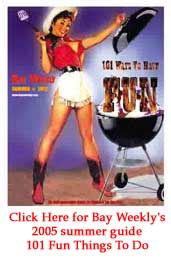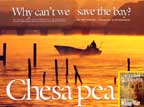|

|
 A Second Helping of Free Food for Thought on Living Waters A Second Helping of Free Food for Thought on Living Waters
The water giveth and the water taketh away
by Sandra Olivetti Martin
Beer and wine flowed and hors d’ouevres and desserts didn’t run out on the 150 people who turned out at Historic London Town and Garden June 1 for a perfect evening beneath high cirrus clouds amid gardens of flowers on green lawns overlooking the South River.
 Nor did food for thought, the other entree promised at Bay Weekly’s book forum on living waters. Nor did food for thought, the other entree promised at Bay Weekly’s book forum on living waters.
The sun had colored the sky and evening chill set in before Bay Weekly co-founder Bill Lambrecht, U.S. Naval Academy Professor Howard Ernst and Bay chronicler Tom Horton finished serving that course.
“The water giveth and the water taketh away,” said Bay Weekly general manager Alex Knoll, introducing the authors. “Where we now stand on the shore of the South River at London Town was once a flourishing seaport. Now, it’s a beautiful park, but it doesn’t have the same vitality as the town of London 300 years ago.
“That’s fitting given the authors with us tonight have all written about the place of water in our world. They’re here to tell us about what water has given us — and now threatens to take back because of what people are doing.”
 For your summer reading, turn to them. For your summer reading, turn to them.
- Lambrecht’s Big Muddy Blues, for a journey up Lewis and Clark’s river west, the Missouri, to see where 200 years have gotten us — and what we must to do to set out on our own historic mission of reconciliation.
“The book deals with environmental policy and hard-boiled politics,” Lambrecht admits. But, he adds, “mainly it’s about people, the characters I met traveling up and down America’s longest river. It’s also a travel guide for people looking for some extraordinary places, like the White Cliffs of Montana that turned Lewis and Clark into enraptured poets.”
- Howard Ernst’s Chesapeake Bay Blues. If you don’t know why we haven’t yet cleaned up the Bay but you know you’re outraged, this take-no-prisoners account should move to the top of your reading list. Find a sample in this week’s Commentary
- Tom Horton could fill your whole summer with his half-dozen books: Water’s Way: Life Along the Chesapeake; The Great Marsh: An Intimate Journey into a Chesapeake Watershed; An Island Out of
 Time: A Memoir of Smith Island in the Chesapeake; Swanfall: Journey of the Tundra Swan; Saving the Chesapeake Bay; Bay Country. Time: A Memoir of Smith Island in the Chesapeake; Swanfall: Journey of the Tundra Swan; Saving the Chesapeake Bay; Bay Country.
Start off with his article in this month’s National Geographic, revisiting his 1993 Geographic article “Chesapeake Bay Hanging in the Balance.”
A dozen years later, Horton told Bay Weekly’s audience, “We’re still asking Can We Save the Bay? This time the title is Why Can’t We Save the Bay? We’ve done a reasonable job of holding the wheel, but we’re really spinning our wheels.”
 Why Can’t We Save the Bay? Why Can’t We Save the Bay?
Tom Horton revisits the Chesapeake in National Geographic
Reviewed by Dick Wilson
If you don’t know by now that the water quality, hence the marine life, of our Bay is threatened, you’ve been living in some kind of time warp where happy fairies go flitting around doing good deeds and giving away tons of money to deserving souls.
We who live in Bay Country prefer to think of ourselves as deserving; we’re environmentally conscious, we faithfully recycle, we decry the decline in the crab and oyster populations and we complain about all the bad stuff that’s flowing into the Bay. But we keep piling the fertilizer on our beautiful green lawns, we continue to drive our gas-guzzling SUVs, we allow development to continue unchecked and we fiercely resist any attempt to take anything away from us. I hate to be the bearer of bad news, but here it is: Not many of us are going to get anything from the good fairy, because we don’t deserve anything.
Tom Horton’s article in the June 2005 edition of National Geographic illustrates the problem: Twice as many of us live and play here as in 1950, and it’s we who generate the pollution that is choking the Bay and its tributaries.
Horton, who has explored the Bay as a writer and sportsman for most of his 60 years, starts his story by describing a kayak trip on an icy February day. He and his friend Don Baugh, an environmental educator at Chesapeake Bay Foundation, brave cold winds, rough water and blowing sleet in their search for “refuge and renewal in these shrinking vestiges of the wilder Chesapeake we knew many years ago.”
Horton finds renewal, but he mourns the state of the Bay now vs. what it was just a few years ago. His story includes descriptions of the daily life of some of the few remaining watermen who make their livings on the Bay, along with exhaustive description of the processes that are damaging the Bay.
With many vivid photographs by Peter Essick, Horton’s article shows the complexity of the predicament in which we find ourselves.
We don’t mess things up on purpose, of course, but not accepting blame doesn’t change or alleviate the problem. The biggest culprit is farm runoff, Horton says, followed by runoff from parking lots, roads and other impervious sources. Note that runoff from a paved area is 40 times more than that from an equivalent wooded area, so as we pave more surfaces we multiply our problems. We dump about 16 times more nitrogen and 30 times more phosphorous into the Bay than the natural load when Captain John Smith arrived in the 1600s. Back then, the water was clear and our 11,600 miles of coastline pristine.
Our problems are legion: Native species such as canvasback ducks, oysters and blue crabs continue to decline in population. Runoff nutrients result in large algae blooms that create a huge deepwater dead zone covering an ever-growing area of the Bay. Underwater grasses that provide protective environments for many marine species, including crabs, have declined by more than 50 percent in the last 50 years.
But Horton sees a few glimmers of light on this gloomy horizon. We take solace from an apparently healthy rockfish population. We see the increasing influence of knowledgeable environmental scientists and we are forcing politicians to take heed and support cleanup efforts. But more needs to be done. As Horton says, “Public support is like the estuary itself, impressively broad but deceptively shallow.”
Horton paints a bleak picture, but as he points out, if we have the will, our Bay may see better times: “If we do right by water quality … we won’t pay for the sins of the past.”
Sample the article and take related journeys at www.nationalgeographic.com/magazine/0506. |
|

 A Second Helping of Free Food for Thought on Living Waters
A Second Helping of Free Food for Thought on Living Waters Nor did food for thought, the other entree promised at Bay Weekly’s book forum on living waters.
Nor did food for thought, the other entree promised at Bay Weekly’s book forum on living waters. For your summer reading, turn to them.
For your summer reading, turn to them.

 Time: A Memoir of Smith Island in the Chesapeake; Swanfall: Journey of the Tundra Swan; Saving the Chesapeake Bay; Bay Country.
Time: A Memoir of Smith Island in the Chesapeake; Swanfall: Journey of the Tundra Swan; Saving the Chesapeake Bay; Bay Country.
 Why Can’t We Save the Bay?
Why Can’t We Save the Bay?